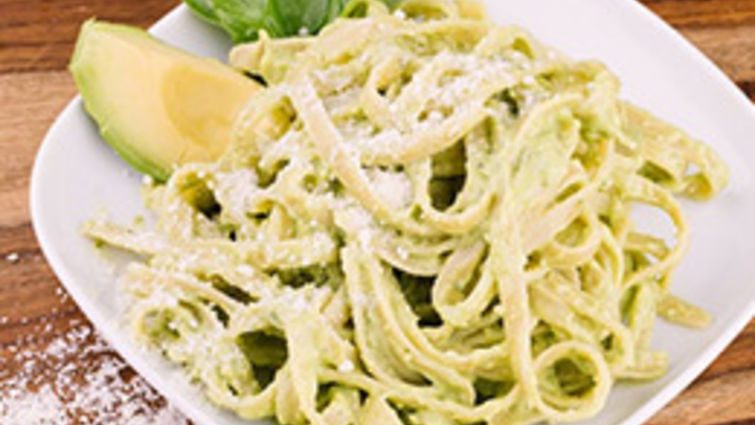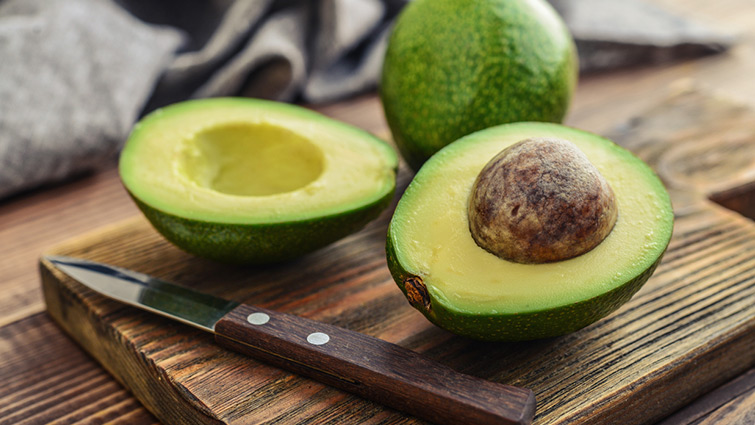Available in English, Spanish, French, Chinese, and Portuguese.
#liveitlomalinda
With its rich and flavorful nutty undertones, avocados provide the perfect backdrop to this twist on traditional Alfredo sauce. Good warm or cold, this scrumptious dish will soon be a delicious family favorite!

Recipe: Avocado Fettuccini
Serving size: 1 cup prepared
Servings per recipe: 4
Prep time: 10 min
Cook time: 10 min
- 8 oz. - Fettuccini noodles, dry
- 1 ea - Avocado, large
- 2 cloves - Garlic
- 1 ea - Lemon, juiced
- Sm handful - Basil, fresh
- 1/4 cup - Milk, 2% (or water) to thin it out
- 1/4 cup - Parmesan cheese, shredded
Directions
Bring a large pot of salted water to a boil. Cook the pasta as directed on package. While the pasta is cooking, make sauce. In a food processor pulse to mince the garlic and basil. Add the lemon juice, avocado, and one tablespoon of water. Process until smooth, scraping sides of bowl as needed. If the sauce is too thick, you can add more water or milk a small amount at a time until you reach desired consistency. Season to taste. Add sauce to noodles and serve warm. To serve cold, thin sauce with milk until desired consistency is reached.
Low-carb option: Serve avocado sauce on top of zucchini noodles!
Suggested toppings: Fresh diced tomatoes, Fresh herbs, minced, Roasted pine nuts
Nutrition Facts
Serving size:
| Calories | 202 |
| Carbohydrates | 27g |
| Fiber | 4g |
| Total Fat | 8g |
| Saturated Fat | 2g |
| Monounsaturated Fat | 4g |
| Polyunsaturated Fat | 1g |
| Protein | 7g |
| Sugar | 2g |

Star Ingredient:
Avocado Contain:
Avocado trivia: Avocados are actually a fruit with more potassium than a banana.
Fiber*
We have all heard we don’t get enough fiber. Do you know why we need fiber? Mainly we need fiber to relieve and reverse symptoms of constipation. Fiber is only found in vegetables, fruits, legumes and whole grains. The fibers of plants are constituents of plant cell walls. Hemicellulose, pectins, gums and mucilages are examples of different types of fiber. Some fibers cannot be digested; however, some can be digested by bacteria in the human digestive tract and can generate some absorbable products which can yield energy when metabolized. Insoluble fibers do not dissolve readily in water while soluble do. Both types contribute to digestive health.
Vitamin B6*
All B vitamins play many specific roles in helping the enzymes to perform thousands of different molecular conversions in the body.
Vitamin B6 has been known to play roles in protein and amino acid metabolism. Besides a weakening immune response, vitamin B6 deficiency is expressed in general symptoms, such as weakness, irritability and insomnia. Other symptoms include a greasy, flaky dermatitis, anemia, and in advanced cases, convulsions. The richest food sources of vitamin B6 are protein-rich meat, fish and poultry. Potatoes, a few other vegetables, and some fruits are good sources, too. Foods lose vitamin B6 when heated.
Potassium*
Potassium is the principle positively charged ion inside the body cells. It plays a major role in maintaining fluid and electrolyte balance and cell integrity. It is also critical in keeping the heartbeat steady. It assists in carbohydrate and protein metabolism. Potassium is abundant inside all living cells, both plant and animal, and because cells remain intact unless foods are processed, the richest sources of potassium are fresh foods of all kinds, especially fruits and vegetables.
*These statements have not been evaluated by the Food and Drug Administration. This is not intended to diagnose, treat, cure, or prevent any disease.









